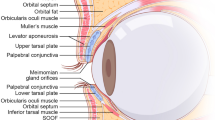Abstract
Purpose
To modify the traditional surgical approach to treat patients diagnosed with congenital lower eyelid entropion using inferior eyelid margin fixation of the orbicularis eyelid muscle.
Methods
Ninety-six participants (180 eyes) with congenital lower eyelid entropion diagnosed between January 2019 and April 2021 were included in this study. The patients were divided into Group A (cutaneous orbicularis oculi excision treatment) and Group B (inferior eyelid margin fixation treatment). The efficiency and recurrence rate of treatments were used to compare the two treatments.
Results
There was no significant difference in age, sex, and eyes distribution in both groups. And higher efficiency rate was found in Group B (P < 0.05). And Group A had a higher recurrence rate in the follow-up after surgical treatment (P < 0.05).
Conclusions
This modified inferior eyelid margin fixation of the orbicularis eyelid muscle treatment is an ideal procedure with a high degree of efficacy and low recurrence rate in patients with congenital lower eyelid entropion.




Similar content being viewed by others
Data availability
The data used to support the findings of this study are available from the corresponding author upon request.
References
Chu YC, Yang JW, Tsai YJ et al (2016) Correction of involutional entropion with retractor redirection. Orbit 35:207–211
Ji SB (2016) Comparison of surgical outcome between quickert suture and quickert suture with modified lateral tarsal strip in involutional lower eyelid entropion. J Craniofac Surg 27:198–200
Wang Y, Li D, Du F, Zhou N, Li J (2018) Efficacy of inverted “V” release surgery in the correction of a special type of epicanthus. Aesth Plast Surg 42(5):1304–1311
Wright M, Bell D, Scott C, Leatherbarrow B (1999) Everting suture correction of lower lid involutional entropion. Br J Ophthalmol 83(9):1060–1063
Yue ZX, Li Y (2011) Clinical observation of deep fixation for the treatment of congenital ingrown impaired eyelashes. Int J Ophthalmol 11(8):1406
Serbest Ceylanoglu K, Malkoc Sen E, Corak Eroglu F, Yenigun S (2021) Comparison of the two techniques for involutional lower eyelid entropion: a retrospective study. J Craniomaxillofac Surg 49(11):1005–1009
Yan Y, Chen T, Wei W et al (2016) Epiblepharon in Chinese children: relationships with body mass index and surgical treatment. J AAPOS 20(2):148–152
Kim MS, Sa HS, Lee JY (2014) Surgical correction of epiblepharon using an epicanthal weakening procedure with lash rotating sutures. Br J Ophthalmol 98(1):120–123
Lim WK, Rajendran K, Choo CT (2004) Microscopic anatomy of the lower eyelid in asians. Ophthal Plast Reconstr Surg 20(3):207–211
Chen B, Liu J, Ni J et al (2019) Lower eyelid tension balance reconstruction: a new procedure for the repair of congenital epiblepharon with epicanthus. J Plast Reconstr Aesthet Surg 72:842–847
Miletić D, Kuzmanović EB (2016) Histopathological in changes in linvolutional lower eyelid entropion: the tarsus is thickened! Can J Ophthalmol 51(6):482–486
Zuo L, Cheng JX, Huang XY et al (2015) Personalized surgical treatment of congenital entropion. Chinese J Med Aesthet Beauty 21(4):212–215
Nakos EA, Boboridis KG, Kakavouti-Doudou AA, Almaliotis DD, Sioulis CE, Karampatakis VE (2019) Randomized controlled trial comparing everting sutures with a lateral tarsal strip for involutional lower eyelid entropion. Ophthalmol Ther 8(3):397–406. https://doi.org/10.1007/s40123-019-0189-3
Meadows AE, Reck AC, Gaston H, Tyers AG (1999) Everting sutures in involutional entropion. Orbit 18(3):177–181
Ranno S, Sacchi M, Gilardi D et al (2014) Retractor plication versus retractor plication and lateral tarsal strip for eyelid entropion correction. Eur J Ophthalmol 24(2):141–146
Damasceno RW, Osaki MH, Dantas PE et al (2011) Involutional entro-pion and ectropion of the lower eyelid:prevalence and associated risk factors in the elderly population. Ophthal Plast Reconstr Surg 27:317–320
Bashour M, Harvey J (2000) Causes of involutional ectropion and entropion-age-related tarsal changes are the key. Ophthal Plast Reconstr Surg 16(2):131–141
Funding
The authors have not disclosed any funding.
Author information
Authors and Affiliations
Contributions
HQ and FY are the guarantor of integrity of the entire study. HQ designed this study and defined the intellectual content. HQ and WY did the literature Research. HQ did the clinical studies. HQ and LH acquired the data. FY and WY analyzed the data. HQ prepared the paper and drafted the paper. Liao H. revised the paper. All authors have read and approved the final paper.
Corresponding author
Ethics declarations
Conflict of interest
All authors declare that they have no conflict of interest.
Ethical approval
All procedures performed in studies involving human participants were in accordance with the ethical standards of the institutional and/or national research committee and with the 1964 Declaration of Helsinki and its later amendments or comparable ethical standards. This study is approved by relevant Ethics Committee of Affiliated Eye Hospital of Nanchang University, and informed consent was obtained from all individual participants included in the study.
Additional information
Publisher's Note
Springer Nature remains neutral with regard to jurisdictional claims in published maps and institutional affiliations.
Rights and permissions
Springer Nature or its licensor (e.g. a society or other partner) holds exclusive rights to this article under a publishing agreement with the author(s) or other rightsholder(s); author self-archiving of the accepted manuscript version of this article is solely governed by the terms of such publishing agreement and applicable law.
About this article
Cite this article
Huang, Q., Fang, Y., Wang, Y. et al. Comparison of the cutaneous orbicularis oculi excision treatment with the inferior eyelid margin fixation treatment for congenital lower eyelid entropion. Int Ophthalmol 43, 2153–2159 (2023). https://doi.org/10.1007/s10792-022-02610-0
Received:
Accepted:
Published:
Issue Date:
DOI: https://doi.org/10.1007/s10792-022-02610-0




